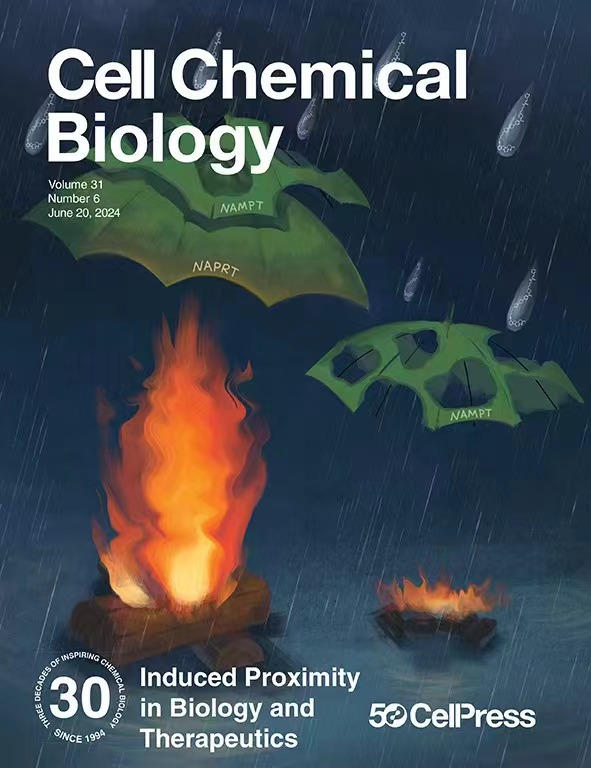Gluetacs Co-publishes Cover Article in CELL| Sub-Journal Reporting NAMPT-targeting PROTAC and nicotinic acid co-administration elicit safe and robust anti-tumor efficacy in NAPRT-deficient pan-cancers |
ON:2024-06-21 TAG:GLUETACS THERAPEUTICS

Recently, Gluetacs Therapeutics and Fan Gaofeng lab from ShanghaiTech University have published an online cover article titled “NAMPT-targeting PROTAC and nicotinic acid co-administration elicit safe and robust anti-tumor efficacy in NAPRT-deficient pan-cancers” in the internationally renowned journal Cell Chemical Biology. The article reports that a new generation of PROTAC degrader targeting the NAMPT protein simultaneously blocks the enzymatic and non-enzymatic functions of the NAMPT protein, and when combined with nicotinic acid, it has shown safety and robust anti-tumor efficacy in NAPRT-deficient pan-cancers.
NAD+(Nicotinamide Adenine Dinucleotide) is a coenzyme involved in redox reactions and various physiological processes such as energy synthesis and DNA repair. There are three synthetic pathways for NAD+ in the body, and NAMPT, as a key rate-limiting enzyme in the NAD+ salvage pathway, is highly expressed in various tumor cells, making it a potential target for cancer treatment. On the one hand, NAMPT functions enzymatically in cells in the form of iNAMPT, responsible for the biosynthesis of NAD+; on the other hand, it can also be secreted outside the cell in the form of eNAMPT to exert non-enzymatic functions, promoting tumor development. Previous strategies targeting NAMPT have mainly focused on the development of traditional enzymatic inhibitors, but their clinical results were poor. In a previous study, the research team developed two compounds, SIAIS630120 and SIAIS630121, using PROTAC technology, which can degrade both iNAMPT and eNAMPT. However, toxicity issues similar to traditional inhibitors have emerged. Therefore, addressing the side effects of targeting NAMPT is crucial.
The research team first validated the sensitivity of various tumor cells to PROTAC targeting NAMPT and found that PROTAC targeting NAMPT had a better efficacy in NAPRT-deficient tumor cells. Therefore, the research team proposed NAPRT-deficient cancers as the potential indications for PROTAC targeting NAMPT protein and combined nicotinic acid to mitigate the side effects.
Given that the two previously developed PROTAC targeting NAMPT have exhibited a significant “Hook effect” at a concentration of 100 nM, the research team optimized the previous PROTAC to obtain a new generation of PROTAC targeting NAMPT (632005). 632005 has low IC50, high degradation profile and excellent metabolic stability.
After obtaining the compound 632005, the research team further validated the feasibility of combining PROTAC targeting NAMPT with nicotinic acid to mitigate toxicity. 632005 treatment exhibited certain side effects, including abnormalities in various blood routine indicators, while nicotinic acid supplementation can effectively mitigate the side effects caused by 632005. Therefore, combining PROTAC 632005 targeting NAMPT with nicotinic acid is a feasible strategy to mitigate the side effects of NAMPT targeting.
To further evaluate the impact of combining nicotinic acid administration on the anti-tumor efficacy of PROTAC, the research team constructed xenograft models of hematologic malignancies, prostate cancer, and patient-derived liver cancer PDX models, and demonstrated that PROTAC targeting NAMPT combined with nicotinic acid can exhibit significant anti-tumor efficacy in NAPRT-deficient pan-cancers.
In summary, the research team found that PROTAC targeting NAMPT has a better efficacy profile in NAPRT-deficient tumor cells, and then developed a second-generation PROTAC, 632005. When combined with nicotinic acid, it effectively mitigated side effects and showed robust anti-tumor efficacy in NAPRT-deficient pan-cancers.
Gluetacs Therapeutics, by publishing this article with academic institutions as a corresponding affiliation, has once again demonstrated the rich technical reserve and translational potential of the GlueTacs® platform, as well as its significant academic valuation and commercial potential.
《Cell Chemical Biology》:https://www.cell.com/cell-chemical-biology/abstract/S2451-9456(24)00208-3